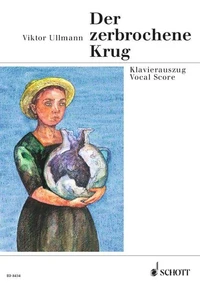Deux chœurs hébraïques. mixed choir (SATB) a cappella. Partition de chœur.
Par :Formats :
- Paiement en ligne :
- Livraison à domicile ou en point Mondial Relay entre le 11 juillet et le 18 juilletCet article sera commandé chez un fournisseur et sera expédié 6 à 12 jours après la date de votre commande.
- Retrait Click and Collect en magasin gratuit
- Livraison à domicile ou en point Mondial Relay entre le 11 juillet et le 18 juillet
- Réservation en ligne avec paiement en magasin :
- Indisponible pour réserver et payer en magasin
- Nombre de pages5
- Poids0.022 kg
- Dimensions19,2 cm × 27,5 cm × 0,0 cm
- ISBN979-0-001-17082-6
- EAN9790001170826
- Date de parution01/01/2010
- CollectionSchott Choral Music
- ÉditeurSchott
Résumé
Viktor Ullmann composed his choral arrangements of Hebrew, Yiddish and Chassidic songs in the ghetto of Theresienstadt in 1943/1944. In the function of "Head of the Studio for New Music", Ullmann made a significant contribution to the so-called "leisure activities" in the ghetto. The works were evidently intended for the repertoire of the various choirs at Theresienstadt, including children's choirs such as the Karel Vrbas Youth Choir in which Ullmann's son Max also sang.
There is no evidence to confirm that Ullmann's choral works were actually performed in Theresienstadt, for example in one of the frequent concerts given by Rafael Schächter's choir of up to a hundred voices (cf. Milan Kuna, Musik an der Grenze des Lebens, 21998. p. 313). The German translations below first appeared in the song book Makkabi-Liederbuch published in Berlin in 1930 (2nd edition 1935) which was available to Viktor Ullmann as a source for the melodies and text orthography for his choral arrangements in Theresienstadt.
Instrumentation : mixed choir (SATB) a cappella
There is no evidence to confirm that Ullmann's choral works were actually performed in Theresienstadt, for example in one of the frequent concerts given by Rafael Schächter's choir of up to a hundred voices (cf. Milan Kuna, Musik an der Grenze des Lebens, 21998. p. 313). The German translations below first appeared in the song book Makkabi-Liederbuch published in Berlin in 1930 (2nd edition 1935) which was available to Viktor Ullmann as a source for the melodies and text orthography for his choral arrangements in Theresienstadt.
Instrumentation : mixed choir (SATB) a cappella
Viktor Ullmann composed his choral arrangements of Hebrew, Yiddish and Chassidic songs in the ghetto of Theresienstadt in 1943/1944. In the function of "Head of the Studio for New Music", Ullmann made a significant contribution to the so-called "leisure activities" in the ghetto. The works were evidently intended for the repertoire of the various choirs at Theresienstadt, including children's choirs such as the Karel Vrbas Youth Choir in which Ullmann's son Max also sang.
There is no evidence to confirm that Ullmann's choral works were actually performed in Theresienstadt, for example in one of the frequent concerts given by Rafael Schächter's choir of up to a hundred voices (cf. Milan Kuna, Musik an der Grenze des Lebens, 21998. p. 313). The German translations below first appeared in the song book Makkabi-Liederbuch published in Berlin in 1930 (2nd edition 1935) which was available to Viktor Ullmann as a source for the melodies and text orthography for his choral arrangements in Theresienstadt.
Instrumentation : mixed choir (SATB) a cappella
There is no evidence to confirm that Ullmann's choral works were actually performed in Theresienstadt, for example in one of the frequent concerts given by Rafael Schächter's choir of up to a hundred voices (cf. Milan Kuna, Musik an der Grenze des Lebens, 21998. p. 313). The German translations below first appeared in the song book Makkabi-Liederbuch published in Berlin in 1930 (2nd edition 1935) which was available to Viktor Ullmann as a source for the melodies and text orthography for his choral arrangements in Theresienstadt.
Instrumentation : mixed choir (SATB) a cappella



